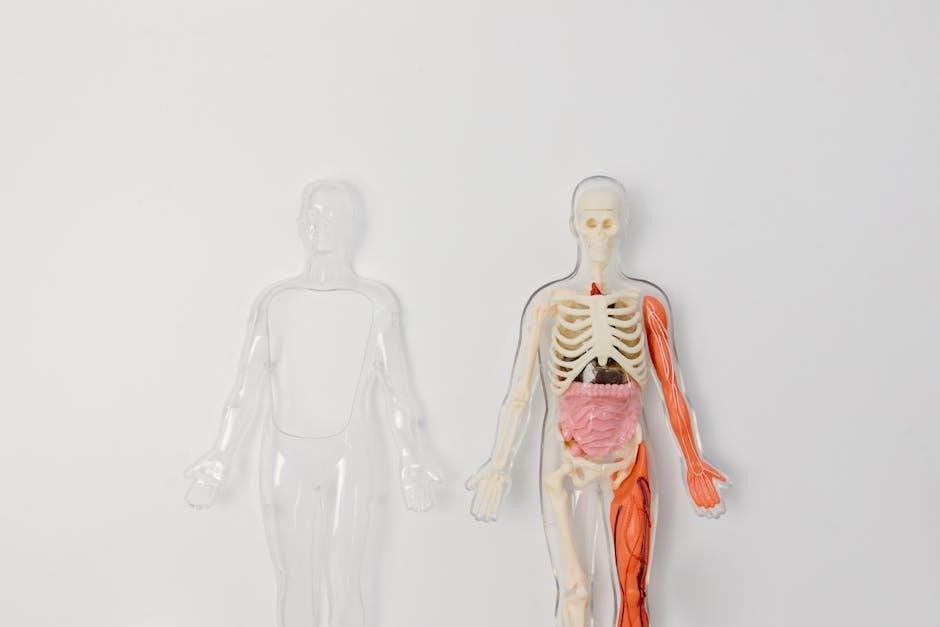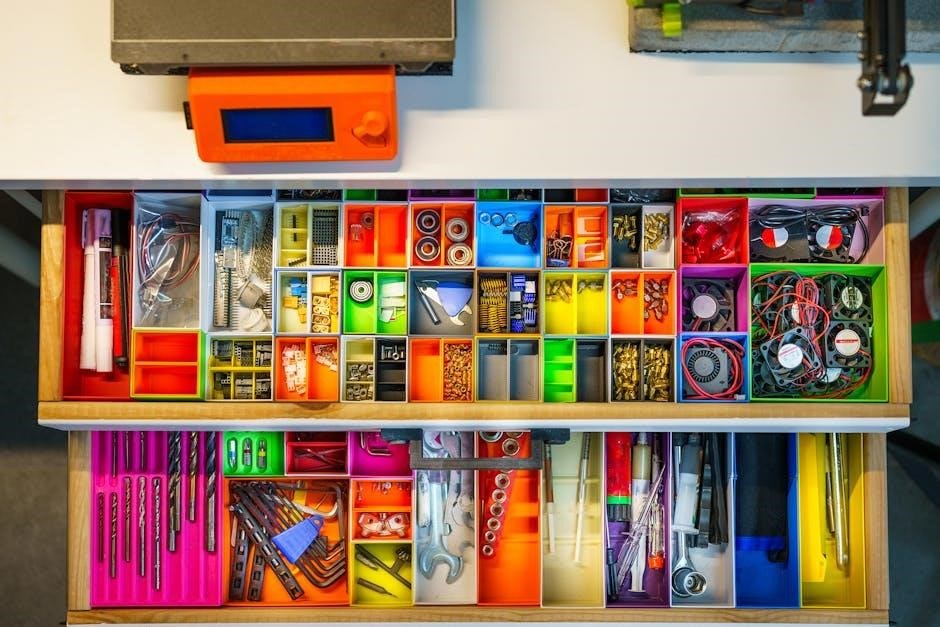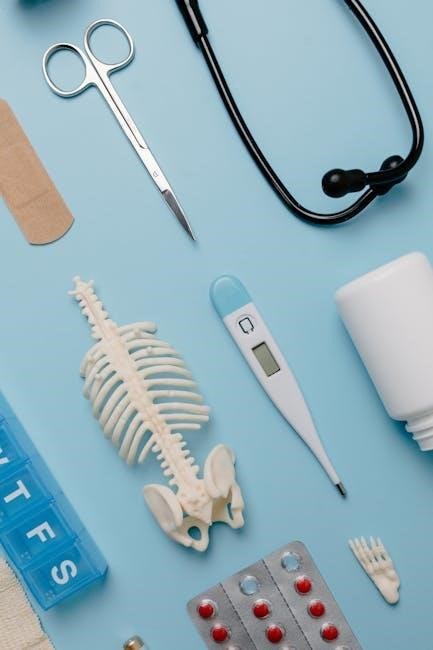Overview of Human Anatomy & Physiology Laboratory Manuals
Human Anatomy & Physiology laboratory manuals are essential tools. They offer hands-on exercises, reinforcing the structure and function of the human body, particularly for healthcare-focused students. These manuals often complement textbooks;

Purpose and Scope of the Manual
This manual aims to guide students through lab activities, enhancing their understanding of human anatomy and physiology. It provides practical approaches to complex concepts, fostering a deeper comprehension of the human body.
Understanding Human Structure and Function
The laboratory manual is carefully crafted to facilitate a comprehensive understanding of human structure and function. Through a variety of experiments and activities, students gain insights into the intricate relationships between anatomical components and their physiological roles. The manual emphasizes hands-on learning to solidify theoretical concepts presented in lectures and textbooks. It encourages exploration of the body’s organization, from cells to organ systems. By engaging with real-world examples and case studies, learners develop critical thinking skills applicable to healthcare professions.
Key Features of Effective Lab Manuals
Effective lab manuals prioritize hands-on activities, clear instructions, and visual aids. They seamlessly integrate with textbooks and online resources. Safety guidelines and assessment tools are also key components.
Experiments for Healthcare Programs
Laboratory manuals designed for healthcare programs feature experiments directly relevant to clinical practice. These exercises emphasize understanding the human body’s structure and function in the context of patient care. Students explore anatomical models, physiological processes, and diagnostic techniques. Such experiments prepare them for real-world scenarios. They gain practical skills in areas like vital signs measurement, musculoskeletal assessment, and neurological examination. The goal is to bridge the gap between theoretical knowledge and clinical application, fostering competent and confident healthcare professionals. These manuals often include case studies and simulations to enhance learning.
Visual Aids and Learning Tools
Effective lab manuals incorporate diverse visual aids to enhance understanding. Anatomical model photos provide realistic representations of structures. Detailed illustrations clarify complex processes, such as muscle contractions or nerve impulse transmission. Microscopic images reveal cellular details, aiding in tissue identification. Diagrams simplify intricate systems, like the cardiovascular or respiratory systems. Additionally, many manuals include interactive elements such as labeling exercises and flowcharts. These tools reinforce key concepts. They promote active learning and improve retention. Visual aids cater to different learning styles, making the material more accessible. This multifaceted approach ensures a comprehensive and engaging learning experience for students.
Essential Topics Covered in the Manual
Anatomy and physiology lab manuals comprehensively cover body regions, cavities, and surface anatomy. These resources also delve into microscopic structures. They explore fundamental physiological processes essential for healthcare students’ understanding.
Body Regions and Surface Anatomy
Laboratory manuals dedicate significant attention to body regions and surface anatomy. These sections guide students in identifying and understanding the various anatomical regions of the human body. Emphasis is placed on palpable structures, allowing students to correlate textbook knowledge with physical landmarks. Surface anatomy knowledge is vital for healthcare professionals. It facilitates physical examinations, injections, and other clinical procedures by providing a practical understanding of underlying structures. Lab activities often involve palpation exercises, anatomical model identification, and surface anatomy demonstrations to promote comprehension and skill development; This practical focus enhances the students’ ability to apply anatomical knowledge in real-world scenarios.
Body Cavities and Abdominopelvic Regions
The exploration of body cavities and abdominopelvic regions forms a crucial part of anatomy and physiology laboratory manuals. Students learn to identify the major body cavities, such as the cranial, thoracic, and abdominopelvic cavities, understanding their boundaries and contents. The abdominopelvic region is further divided into quadrants or regions, and lab exercises focus on locating organs within these divisions. Manuals emphasize the relationships between organs and their positions within these cavities, enhancing comprehension of anatomical organization. Activities may include dissections, anatomical model studies, and imaging analysis. This knowledge is fundamental for diagnostic procedures and clinical interpretations, providing a spatial framework for understanding human anatomy.
Hands-on Activities and Exercises
Laboratory manuals emphasize hands-on activities. Dissections, model studies, and physiological experiments enhance understanding. These activities are designed to solidify theoretical knowledge. They promote active learning and critical thinking.
Microscopic Observation Techniques
Effective human anatomy and physiology laboratory manuals provide comprehensive guidance on microscopic observation techniques. Students learn to prepare slides, stain tissues, and identify cellular structures. Detailed instructions on using microscopes, adjusting focus, and optimizing lighting are included. Manuals illustrate various tissue types and cellular components. They explain the significance of different staining methods. Students gain proficiency in recognizing histological features. This skill is crucial for understanding tissue organization and function. Practice with unknown samples reinforces learning and develops observational skills. These skills are vital for careers in healthcare.

Digital Resources and Online Integration
Modern human anatomy and physiology laboratory manuals integrate digital resources. These resources include online homework systems, virtual labs, and interactive simulations. These enhance learning beyond the traditional lab setting and improve student engagement.
Mastering A&P and Online Homework Systems
Mastering A&P represents a leading online homework and learning platform designed specifically for anatomy and physiology courses. This system often accompanies laboratory manuals, providing students with interactive tools to assess their understanding of key concepts. Features commonly include pre-lab quizzes, dynamic study modules, and personalized feedback to guide student learning. By integrating with the lab manual, Mastering A&P helps students prepare for lab activities, review material after the lab, and ultimately achieve a deeper comprehension of human anatomy and physiology. These systems ensure efficient learning both inside and outside the lab.
Lab Videos and Practice Anatomy Lab (PAL)
Many modern Human Anatomy & Physiology lab manuals integrate digital resources such as lab videos and Practice Anatomy Lab (PAL) to enhance the learning experience. Lab videos demonstrate key procedures and dissection techniques, offering students a visual guide before and after hands-on activities. PAL provides virtual anatomy resources, including 3D models and dissection simulations, that allow students to explore anatomical structures in detail. These digital tools support diverse learning styles and enable students to review complex concepts at their own pace, promoting a deeper understanding of anatomy beyond the physical lab setting. The video and PAL make learning more efficient.
Customization and Adaptability
A key feature of effective Human Anatomy & Physiology lab manuals is their adaptability. They should offer customizable exercises and content. This allows instructors to tailor the manual. It helps meet specific course needs and student learning styles.
Adapting to Different Textbooks
A valuable characteristic of a well-designed Human Anatomy & Physiology laboratory manual is its ability to adapt to various textbooks. While some manuals are created to directly align with a specific textbook, the ideal manual offers flexibility. It allows instructors to use it alongside different A&P texts. This adaptability is achieved through the manual’s focus on core concepts and fundamental laboratory techniques. It isn’t overly reliant on the specific content organization of any single textbook. Instructors can easily integrate exercises and experiments from the manual into their existing course structure. This ensures a cohesive learning experience for students.

Considerations for Lab Safety and Procedures
Lab safety is paramount in any Human Anatomy & Physiology laboratory setting. A comprehensive lab manual must dedicate a significant section to outlining safety protocols and procedures. These guidelines should cover a wide range of potential hazards. This includes the proper handling of chemicals, biological specimens, and equipment. Clear instructions on waste disposal are also essential. Students must understand the importance of personal protective equipment. This includes gloves, eye protection, and lab coats. The manual should also include emergency procedures. This involves how to respond to spills, accidents, or injuries within the lab environment, to ensure a safe learning experience.
Available Editions and Formats
Human Anatomy & Physiology laboratory manuals often come in various editions. This includes main versions, cat versions, and fetal pig versions. They are available to cater to specific course needs and dissection requirements.
Main, Cat, and Fetal Pig Versions
Laboratory manuals for Human Anatomy & Physiology are frequently offered in multiple versions to accommodate diverse educational needs. The “Main” version typically covers a broad range of topics suitable for general A&P courses. “Cat” versions provide dissection exercises focused on feline anatomy, offering a mammalian model for comparison. “Fetal Pig” versions utilize fetal pig dissections. These versions allow students to study mammalian anatomy at a more accessible scale and cost. The choice of version depends on the curriculum’s emphasis and available resources, providing flexibility for instructors and a tailored learning experience for students.

The role of laboratory manuals in modern education
In modern education, laboratory manuals play a crucial role in solidifying theoretical knowledge of Human Anatomy & Physiology through practical application. These manuals provide structured, hands-on activities that enhance understanding of complex concepts. By engaging students in experiments, dissections, and microscopic observations, laboratory manuals foster critical thinking and problem-solving skills. Furthermore, they bridge the gap between classroom learning and real-world applications, particularly in healthcare fields. With the integration of digital resources and visual aids, modern laboratory manuals offer a comprehensive and engaging learning experience, preparing students for future success.
